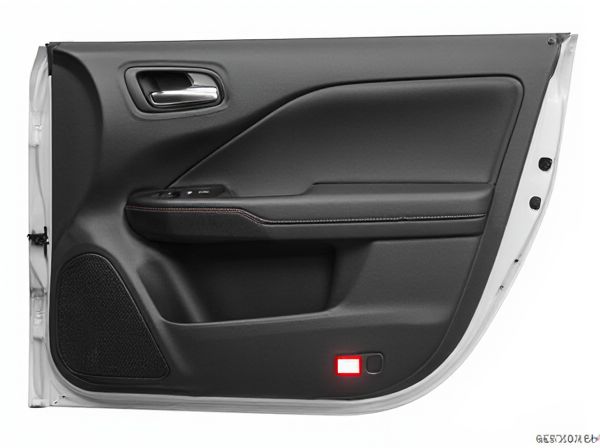
Photo illustration: Kick-to-Open Door vs Manual Open Door
Kick-to-open doors provide hands-free convenience and improve hygiene by minimizing contact, making them ideal for busy environments or healthcare settings. Manual open doors require physical touch, which can increase the spread of germs but offer a straightforward, cost-effective solution. Your choice depends on the balance between accessibility needs and budget considerations.
Table of Comparison
| Feature | Kick-to-Open Door | Manual Open Door |
|---|---|---|
| Operation | Foot gesture activated sensor | Hand-operated handle |
| Convenience | Hands-free access, ideal when carrying items | Requires free hand to open |
| Installation Complexity | Requires electronic sensors and wiring | Simple mechanical installation |
| Power Requirement | Battery or vehicle power needed | No power needed |
| Maintenance | Sensor calibration, battery replacements | Minimal, mainly lubricating hinges |
| Cost | Higher initial cost | Lower initial cost |
| Reliability | Dependent on sensor functionality | Highly reliable, mechanical |
| Safety | Auto-stop on obstruction | Manual control reduces accidental operation |
Introduction to Door Mechanisms: Kick-to-Open vs Manual
Kick-to-open doors utilize a sensor or mechanical trigger activated by a foot tap, enabling hands-free entry that enhances hygiene and convenience in high-traffic areas. Manual doors require physical grip and pull or push actions, relying on traditional handles or knobs that offer straightforward operation but can transfer germs. The choice between kick-to-open and manual mechanisms depends on factors such as user accessibility, sanitation needs, and building usage patterns.
How Kick-to-Open Doors Work
Kick-to-open doors utilize a pressure-sensitive mechanism integrated within the door or frame that detects a gentle kick or push, triggering an automatic opening system, often powered by a small motor or pneumatic actuator. These doors commonly feature sensors, like infrared or motion detectors, which activate the door latch release, allowing hands-free entry and enhancing accessibility and hygiene in commercial or residential settings. In contrast, manual open doors rely solely on physical force applied directly to handles or push bars, requiring users to touch surfaces and manually overcome latch resistance.
Manual Open Doors: Traditional Simplicity
Manual open doors offer reliable, traditional simplicity with no reliance on electronics or sensors, making them ideal for environments where durability and low maintenance are essential. Their straightforward mechanism reduces the risk of malfunctions and allows for consistent, tactile control over entry and exit. In contrast to kick-to-open doors, manual doors provide a familiar user experience and are often preferred in high-traffic or industrial settings for their robustness and ease of repair.
Installation Requirements and Costs
Kick-to-open doors require specialized sensors and control units for installation, leading to higher upfront costs compared to manual open doors that only need traditional door hardware. Installation of kick-to-open systems often demands professional electrical work and calibration, increasing both labor time and expenses. Manual doors are more cost-effective with simpler installation, requiring minimal tools and standard door components.
User Convenience and Accessibility
Kick-to-open doors provide enhanced user convenience by enabling hands-free access, which is especially beneficial when carrying items or for individuals with limited mobility. Manual open doors require physical effort and can pose challenges for people with disabilities or those encumbered by objects, reducing overall accessibility. Hands-free technology in kick-to-open doors streamlines entry, improving accessibility in public and private spaces by minimizing physical barriers.
Durability and Maintenance Considerations
Kick-to-Open doors feature robust sensors and mechanisms designed for frequent use, reducing wear on handles but requiring periodic sensor calibration and cleaning to maintain optimal functionality. Manual open doors rely on durable mechanical components but endure more physical strain on handles and hinges, leading to higher maintenance needs such as lubrication and part replacements. Overall, kick-to-open systems demand proactive electronic upkeep, while manual doors necessitate consistent mechanical care to ensure long-term durability.
Safety and Security Features Compared
Kick-to-open doors enhance hygiene by enabling hands-free access but may pose security risks if sensor systems are compromised or bypassed. Manual open doors rely on physical interaction, allowing more controlled access and reducing the chance of unauthorized entry due to mechanical locks and user vigilance. Both systems require proper maintenance and integration with security protocols to ensure optimal safety and protection.
Energy Efficiency and Sealing
Kick-to-open doors typically feature automatic sealing systems that minimize air leakage, enhancing energy efficiency by maintaining consistent indoor temperatures. Manual open doors often rely on less precise sealing methods, leading to greater heat loss and increased energy consumption. Effective sealing in kick-to-open doors reduces HVAC workload, supporting sustainable building design and lowering utility costs.
Ideal Use Cases and Environments
Kick-to-open doors excel in high-traffic environments such as hospitals, commercial kitchens, and retail stores where hands-free operation enhances hygiene and efficiency. Manual open doors remain ideal for residential buildings or low-traffic areas where tactile feedback and security are priorities. Choosing the appropriate door mechanism depends on user accessibility needs, sanitation requirements, and frequency of door use.
Which Door Solution Fits Your Needs?
Kick-to-open doors offer hands-free convenience ideal for high-traffic areas and accessibility needs, reducing contact points and enhancing hygiene. Manual open doors provide simplicity and cost-effectiveness, suitable for spaces with lower foot traffic or where tactile control is preferred. Assess your environment's traffic volume, hygiene requirements, and user accessibility to determine the optimal door solution.
 caratoz.com
caratoz.com